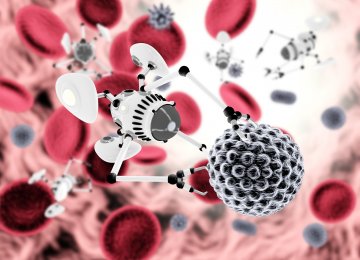The National Cancer Research Network of Iran has set three new goals to be achieved in the next fiscal year that begins in March, according to Deputy Health Minister Dr. Mohammad Aqajani.
To ensure that all cancer patients are covered with the required treatment, the network has placed equitable access to facilities, promotion of high quality services, and development of competent human resources on its agenda.
“Medicines account for only 8-11% of cancer treatment costs in developed countries, whereas the figure is 50% in Iran, equal to 15 trillion rials ($380 million),” he said, addressing a conference on ‘National Move to Counter Cancer’ on Sunday at Mahak Charity, Mehr News Agency reported.
“The reason for this high cost is lack of required infrastructure in radiotherapy and surgical oncology,” he said.
Annually, $290 billion is spent directly on cancer by families or state organizations worldwide, about $760 million of which is in Iran. Globally, the direct and indirect financial burden of cancer is 3% of the world GDP or $1,600 billion, while the non-communicable disease costs 100 trillion rials ($2.5 billion) in Iran.
“As the leading cause of death worldwide, the cost of cancer for families and the government is 19% more than that of cardiovascular diseases,” Aqajani noted.
According to him, the five-year survival rate for cancer in Iran is 71% for breast cancer and 41% for colorectal cancer, while it is 89% and 65% in the US, respectively.
The five-year survival rate is the percentage of people who live at least five years after being diagnosed with cancer. For example, a 5-year survival rate of 90% means that an estimated 90 out of 100 people who have the disease are still alive five years after being diagnosed.
A 10-year roadmap has been devised by the National Cancer Committee supervised by the Health Ministry. Additionally, the committee has drawn up a charter on cancer patient care, and development of cancer care workforce.
The ministry has plans to develop cancer centers for primary and advanced care, including 148 type 1 centers, 131 of which are currently being completed. Type 1 centers offer early diagnosis and screening services, while type 2, and type 3 offer treatment and specialized services such as chemotherapy, radiotherapy, and rehabilitation.
Official studies say before implementation of the National Plan on Cancer Screening under the 2014 Health reform Plan, measures in secondary prevention of highly preventable cancers including breast cancer were lackadaisical.
Three-Fold Increase
Currently, more than 300,000 people suffer from cancer in the country and annually 90,000 new patients are diagnosed with the disease. During the last decade, the number of identified cancer cases (of all types) increased three-fold and each year, 45,000 people lose their lives.
Although the incidence of new cases of breast cancer in Iran is less than the global average (30 per 100,000), the rate of early detection and treatment is significantly low. Annually, 10,000 new cases of invasive breast cancer are diagnosed among Iranian women and 3,000 women die, which means one-third of the cases end in death due to late diagnosis.
On the sidelines of the conference, Health Minister Hassan Qazizadeh Hashemi officially unveiled and directed 200 clinical guidelines to standardize clinical service to patients including those suffering from cancer.






Add new comment
Read our comment policy before posting your viewpoints